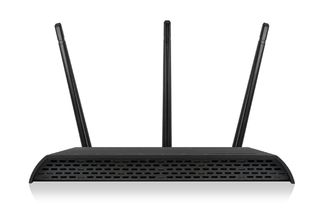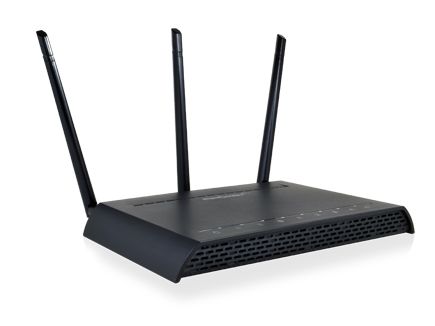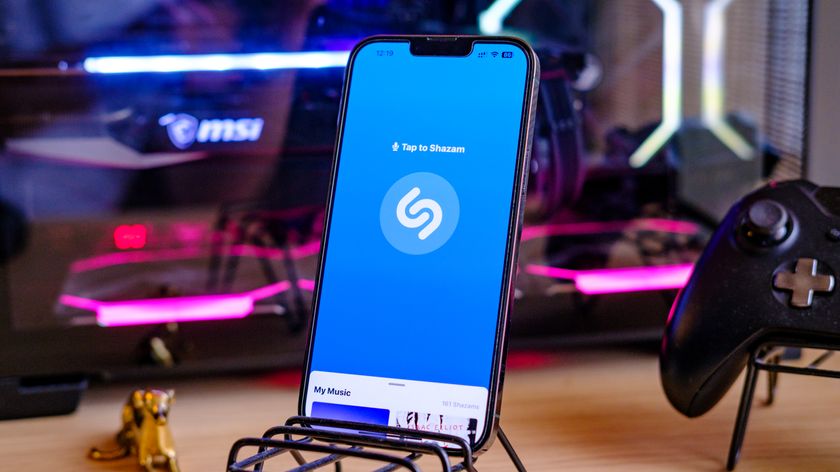Tom's Guide Verdict
The Amped Wireless RTA1750 offers superior range, thanks to its 12 amplifiers, but its overall performance isn't as fast as competing routers.
Pros
- +
Flexible setup and configuration
- +
12 amplifiers
- +
Three high-gain antennas
- +
Excellent range
- +
Inexpensive.
Cons
- -
Mediocre overall bandwidth
- -
USB 2.0 only
- -
No USB printing.
Why you can trust Tom's Guide
Amped Wireless's RTA1750 can be a powerful ally with a dozen signal amplifiers and a trio of sensitive antennas, which boost the range of this 802.11ac router to new lengths. At $180, this device doesn't set any performance records, but it is a good value for those with lots of space to fill with wireless data.
Design
One of the smallest 802.11ac routers available, the RTA1750 is about the size of a paperback book, at 8.9 x 6.1 x 1.1 inches. That's about one-third the size of Netgear's R8000.
As is the style with networking gear these days, the sharply angular RTA1750 is all black. It can be set up horizontally on a table or shelf or screwed into wall, but doesn't come with a stand. It has cooling vents in the front and top and doesn't need a fan to keep its cool.

Inside, the router has some powerful hardware using six high-output amplifiers for increased transmission range and six low-noise amplifiers for greater reception sensitivity. They have an output of 800 milliwatts. Plus, at 5dBi, the router's three 7-inch antennas have a lot more gain than standard stub antennas; they are removable, can swivel 360-degrees, and the router uses the latest beam-forming techniques to sculpt the signal to best suit the receiving antennas.
Rather than looking like a Christmas tree with lots of flashing red and green lights, the RTA1750 has a demure row of nine LEDs near the front, all of which glow white when active. There are lights to show it's powered on, has an Internet connection, its two bands are transmitting, and whether the LAN ports and the USB connection are active. Happily, for those who want a stealth router, these can be turned off with a button in the back.
MORE: Best Wi-Fi Router 2015
Along the RTA1750's back are four Gbps LAN ports and a USB 2.0 port, not the newer 3.0 spec. Plus, it can be used only with a data drive, not a printer. By contrast, the R8000 has both USB 2.0 and 3.0 ports and works with drives and printers. There are buttons for turning the RTA1750 on and off, activating its Wireless Protected Setup (WPS), as well as one for resetting the router's software.
Setup
It takes about five minutes to go from a sealed box to a fully operational Wi-Fi network using the RTA1750. After screwing in the three antennas and connecting the router to your broadband modem with the supplied Ethernet cable, it's time to power up the router. There's no CD to run, although the router comes with a disc that contains its manual, setup videos and the company's Wi-Fi Analytics Tool.

You'll need to point a connected Web browser at "setup.ampedwireles.com" or the router's native IP address (192.168.3.1). The start-up wizard pops up and guides you through the configuration process by detecting your Internet feed. It lets you name the networks and set the security details, which is a good idea because the router is inherently insecure as it comes from the factory. After a quick restart, the RTA1750 was streaming data.
Those of an adventuresome nature can do it all from scratch, using the RTA1750's Dashboard pages. It can be set up as a router or access point, but it lacks the ability to simulate configuration changes, which is included with the Trendnet TEW-812DRU.
There's an automatic method for updating its firmware and the RTA1750 allows you to make minute adjustments to a wide variety of operational parameters. In addition to setting it up for IP V.6 operations, you can easily reconfigure the router's channel width and beacon interval, as well as tweak the frequency and RTS thresholds. Overall, it is one of the most configurable and flexible routers on the market.
Because of its amplifiers, you might need to actually reduce the router's wireless reach to reduce overflow outside the confines of your house or apartment. The RTA1750 lets you adjust its output for 15, 35, 50, 70 and 100 percent, although I ran it full blast.

I was able to manually connect the RTA 1750 with a variety of clients, including tablets, notebooks and desktops, as well as Internet radios and printers. You can use the system's built-in WiFi Protected Setup (WPS) system to automatically connect or do it manually.

The RTA1750 is on top of security with the ability to use WEP, WPA, WPA 2 or WPA mixed-mode protocols. It can authenticate clients using a Radius server and the router has both Stateful Packet Inspection (SPI) and Network Address Translation (NAT) firewalls to keep hackers at bay. If others will be using the network, the RTA1750 lets you set up eight different guest LANs.
In addition to Quality of Service software that can prioritize traffic based on IP address, range or MAC address, the router has parental controls. It can be set up to go dead on a schedule so that the little ones can get to sleep or do their homework. It can show a list of connected clients and has a traffic meter that displays the data flow into and out of the router for wireless and wired connections.
Wi-Fi Analytics Tool
Amped Wireless Wi-Fi Analytics Tool app is a geek's dream come true. It not only lets you look for interfering routers in your neighborhood, but you can check out signal strength levels. There's even a widget for placing this info at a finger's touch on your phone or tablet. There are versions for PCs and Android systems, but not for iPhones and iPad.
The best part is that the data is presented in beautiful graphs that are continuously updated. They can be tweaked, but unlike the Netgear Genie software you can't survey who's connected to the network using the Analytics Tool.
Performance
The RTA1750 has a maximum throughput of 450 Mbps for the 2.4-GHz band as well as 1.3 Gbps for the 5GHz band. That adds up to a peak theoretical bandwidth of 1.75 Gbps. Inside, the RTA1750 has a 700-MHz Qualcomm Scorpion processor with 128MB of RAM. While it is not enabled in the router's firmware, the router has Qualcomm's VIVE Mu-MIMO transfer protocol built-in for boosting throughput in the future.
In real-world testing using Ixia's ixChariot software, the RTA1750 failed to reach the top of the heap. It was able to stream 389.5 Mbps across its two wireless bands at a distance of 5 feet. That's slower than the current champ, the Trendnet TEW 812-DRU’s 446 Mbps data flow, which peaks at 15 feet.

In 2.4-GHz mode, the Amped Wireless reached a peak of 59.5 Mbps 5 feet from the router, making it one of the slowest routers in that category. It was well short of the Netgear R8000's 97.8Mbps of data and lower than the average of 67 Mbps, but ahead of the Belkin F9K1118's anemic 22.8Mbps.
As far as range goes, in our office setting with lots of competing Wi-Fi LANs, the RTA1750 lost its connection short of 140 feet. Using a Portege Z20t tablet in the less-crowded airspace of a suburban home, the RTA1750 set the record for 2.4-GHz range with the ability to stay online 175 feet from the router, 10 feet farther than the Netgear R8000.
MORE: Smart Home Guide
The RTA1750's results improved markedly in 5-GHz mode, but still wasn't top-of-class. At a distance of 5 feet, the router notched 330.0 Mbps. That’s off the 361.3 Mbps pace set by Asus's RT-AC68U and just behind the company's AC1200, but ahead of the Netgear R8000's 302.4 Mbps as well as the average of 297 Mbps. At 140 feet, the RTA1750 hit 74.4 Mbps, again, well below the Asus router's 291.7, as well as the average of 159.8 Mbps.
The RTA1750 easily passed my saturation test, during which I play a NetFlix movie on an Android tablet, watch a TV show on a Windows PC and listen to an Internet radio, while swapping data with a networked drive. Its video never stuttered or froze.
Warranty
The router comes with a one-year warranty that's one-third as long as the coverage for the Trendnet TEW 812-DRU.
Bottom Line
If you care about staying connected from long distances, the Amped Wireless RTA 1750's record-setting range makes this router worth owning. I also like the informative Wi-Fi Analytics Tool and flexible setup. However, this $180 router is a middle-of-the-pack performer in terms of throughput overall. The Trendnet TEW 812DRU ($149) and the Asus's RT-AC68U ($199) offer greater bandwidth, but the RTA1750 is one to get if you have a large home that needs filling with a Wi-Fi signal.
Specs
Wi-Fi Spec: 802.11ac/dual Band
Number of Antennas/Removable: 3/Yes
Ports: 4Gbps LAN, USB 2.0
Peak 802.11ac performance: 389.5 Mbps
Range in 2.4GHz mode: 175 feet
Size: 8.9 x 6.1 x 1.1 inches
Brian Nadel is a freelance writer and editor who specializes in technology reporting and reviewing. He works out of the suburban New York City area and has covered topics from nuclear power plants and Wi-Fi routers to cars and tablets. The former editor-in-chief of Mobile Computing and Communications, Nadel is the recipient of the TransPacific Writing Award.




